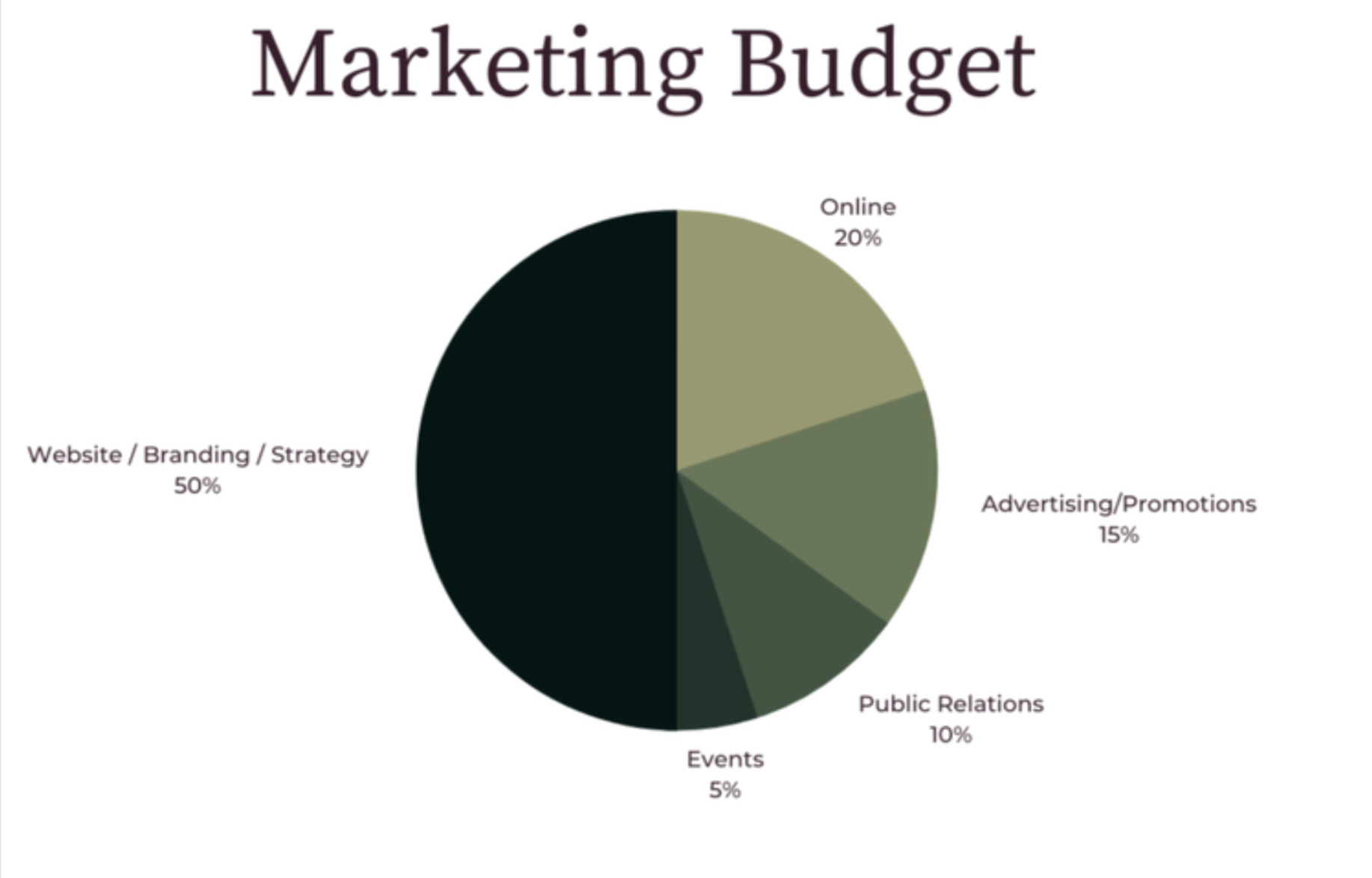HOW MUCH SHOULD SMALL BUSINESSES SPEND ON MARKETING
Running a small business is HARD. In fact, a Wakefield research survey found that “one-third of Americans are more afraid to start their own business than to jump out of a plane.” (Wakefield). Personally, the plane sounds scarier, but that’s because with the right systems and resources allocated, it makes it simpler to run a business (and I’m terrified of heights). Knowing how much to spend on things like marketing and salaries is an important factor in growing a successful business
Let’s talk marketing budgets.
CREATING A BUDGET FOR A SMALL BUSINESS
A company’s budget is an overview of the business’s accounting. It outlines the key information on the state of finances, helps you create goals, and directs your financial decisions.
Like any other budget, first, it’s best to tally up all your sources of revenue and expenses (fixed and variable). After you discover all your expenses, you must factor in the one-time expenses that may occur. Once you subtract your expenses from your total income, you have your pro forma net income and finally, an efficient budget.
WHY IS MARKETING IMPORTANT FOR SMALL BUSINESSES?
Marketing is one of the most important aspects of growing a business because it’s an effective method for spreading the word about how your business is unique and what your business has to offer. Marketing helps a business connect with potential customers through brand recognition, engage with current customers through luxury client experience, and show the value your product or service gives to your community. It is valuable for your small business because it allows you to connect with clients/customers and prove to them the value of your product or service, and it will create brand recognition.
Let’s first talk about brand recognition. At the beginning of your customer’s journey, creating brand recognition for your small business is essential and it is almost impossible to do without marketing. The goal is to have your ideal audience familiarize themselves with your brand so they recognize it through visual materials.
The goal of creating brand recognition is for people to be able to recognize a brand and what they have to offer through its visual elements, such as a logo, a social media post, or packaging. Brand recognition for a small business is essential because it will help your business grow and give you a chance to connect with potential customers. There are many different channels you can use to create brand recognition through marketing such as:
- Social media
- Paid Advertisement
- SEO
- PR and strategic partnerships
- Opt-ins for email marketing
- Etc.,
Using these channels (and more) for marketing is a way for customers to discover what your business has to offer
DECIDING HOW MUCH TO ALLOCATE TO MARKETING

Once you have your budget set, it is time to decide how much to allocate toward marketing. You’ll want to divide the investment set aside for marketing into two efforts: brand development costs (website, blogs, sales, etc.) and promotion costs (advertising, events, and campaigns). This budget depends on the stage of growth for your business and what industry you are in.
For example, a B2C company might spend significantly more on social media marketing than a B2B company. Also, if you are in an early stage of growth, you might find yourself spending more on marketing than a company that is already established. Some companies that are just starting off might spend up to 20% on marketing efforts, whereas a company that is positioned well in the market would spend around 7-8% of its revenue on marketing efforts because they have already built good brand recognition. To understand what’s right for you, follow these three steps to define channels you should prioritize based on your goals:
STEP 1: GOALS
First, define your marketing goals. These goals should be specific, measurable, attainable, relevant, and time-bound. Some examples of goals could be:
- Increase online shop conversion rate by 10%
- Increase email marketing open rate to 20%
- Double website traffic over the next year
- Increase organic search ranking for specific keywords from 10th to 1st on the search engine results page
- And many more based on what your company has in mind for their marketing efforts
Learn more about setting small business marketing goals by clicking HERE.
STEP 2: REDEFINE
Take a look at what you are spending your marketing on now and decide what’s giving you the most ROI based on your goals. ROI doesn’t always mean direct sales; It could mean increased brand awareness, high social media engagement, or increased client satisfaction.
For example, if you have been paying for ads on Google, and one of your goals is to increase organic search ranking, designate the money used for paid ads to an SEO strategy to help you check off your goals.
Let’s dive into the different tactics that may help you reach your marketing goals.
Public relations (PR)
Public relations is an important effort within your overall marketing budget. Think of PR as a method of expansion: a way to use thought leadership and other people’s audiences to amplify your brand authority and recognition.

Website design & user experience
Creating a nice-looking and efficient website is key to standing out in the market and growing your company. 85% of online purchases are made after looking at a website and it takes about 50 milliseconds (that 0.05 seconds) for users to form an opinion about your website that determines whether they like your site or not, whether they’ll stay or leave. A FRACTION OF A SECOND. A fraction of a second is all a company gets to set a good impression or else they risk losing a potential customer for life.
Social media
Social media is one of the best ways to grow and nurture leads. But although social media is an owned platform, this budget mainly comes down to manpower.
Traditional media
Even though social media is taking over, it is still important to think about traditional media and in-person activations to grow your brand recognition. Think about TV commercials, print ads, billboards, panel events, networking events, radio and podcast ads, and more. Traditional media can reach the masses and can help you widen your horizon of customers.
Search engine optimization (SEO)
When you’ve Googled something, how often do you click on “page 2”? Never, right?! SEO does not just increase the organic search traffic to your site, but it also builds thought leadership through targeted blog post writing. SEO is typically complemented with paid search marketing.
Email and SMS marketing
Email and SMS marketing has proven themselves a great way to personally connect with and nurture your customers. Investing time and effort into these strategies can make your company stand out in the market.
STEP 3: ALLOCATE
Let’s say you have a small business with a revenue of $500,000 and feel like you’re well-positioned and established in the market. It’s recommended that allocating 7% of your revenue to your marketing costs will show you the most significant ROI for your resources.
Below is an example of how we recommend clients divide that budget between website/branding/strategy, online marketing, advertising/promotions, public relations, and events. The pie chart below shows the ideal way to allocate your marketing budget. Of course, this will always be subject to change depending on the needs of your business and goals, but this is a great outline to start!
Your budget could look something like this:

Annual revenue: $500,000
Marketing allocation (7%): $35,000
- Website and branding: $17,500
- Online marketing: $7,000
- Advertising/promotions: $5,250
- Public relations: $3,500
- Events: $1,750
RUNNING A SUCCESSFUL SMALL BUSINESS
Now that you have set defined goals, created a marketing plan, and constructed a budget, your business is on the path to becoming even more successful. There are about 30 million small businesses in the United States, some of them your competition! From our experience and research, assigning roughly 7% of your revenue to marketing is what will make your business stand out against others. Now think back, would you still rather jump out of that plane?
LEARN MORE
Nolia Roots can take your marketing to the next level. Read our Case Studies to see how we transformed our clients’ businesses with real results.
